Sustainability Why It’s Time To Start Planting More Seagrass In Our Oceans Jamie Hailstone Contributor Opinions expressed by Forbes Contributors are their own. I write about air quality and the environment. New! Follow this author to improve your content experience.
Got it! Jul 27, 2022, 04:10am EDT | New! Click on the conversation bubble to join the conversation Got it! Share to Facebook Share to Twitter Share to Linkedin (GERMANY OUT) Seagrass Meadows, Cenderawasih Bay, West Papua, Indonesia (Photo by Reinhard . . .
[+] Dirscherl/ullstein bild via Getty Images) ullstein bild via Getty Images Barely a day goes by without some announcement about tree planting, as part of a corporation’s net zero commitments. Let’s be clear – having more trees on the planet is always something to be welcomed – not least because they can absorb carbon, cool the air around us and are good for our mental health. But tree planting is so last year.
When it comes to protecting the environment, there’s a new kid in town – blue carbon – which is carbon stored in coastal and marine ecosystems. And if you want to score big on blue carbon, you want to plant seagrass. Seagrass covers about 0.
1% of the ocean globally and provides 18% of its carbon storage, but it is shrinking by 7% each year – the equivalent to a soccer pitch worth vanishing every 30 minutes – according to a 2020 UN report . It also provides breeding grounds for fish such as cod, plaice, pollock, and sharks, as well as providing a habitat for endangered wildlife including stalked jellyfish, short snouted seahorses and spiny or ‘long snouted’ seahorses. One of the companies who have joined the “blue carbon” revolution is the international insurance firm Zurich, which has just launched a partnership with the Marine Conservation Society (MCS) to help plant and restore more than 10,000 square meters of seagrass around the U.
K. coast over the next 12 months. MORE FOR YOU Is Carbon Capture Another Fossil Fuel Industry Con? Sustainable Fashion Wants Brands To Redefine Business Growth Trouble With Predicting Future Of Transportation Is That Today Gets In The Way The company expects the work with the MCS to sustain the recovery of more than 10,000 square meters of seagrass over 12 months, equivalent to 51 tennis courts.
Zurich’s chief sustainability officer, John Keppel said it has been involved with “significant tree planting exercises for some time” as part of a range of nature-based solutions in its “armoury”, but he added it was drawn to seagrass because of the additional benefits it can provide. “Whilst we continue to be committed to planting trees in forests, we’ve also been searching for alternatives and sea grass works for Zurich,” he explained. “It feeds into the important issue of biodiversity.
It’s also local and in places that people recognize. It’s more real for our U. K.
community and it will also have a positive impact on the local coastline ecosystem. ” The insurance giant will work with the MCS to recover one square metre of seagrass for every Zurich customer that claims for escape of water or flood damage over the next year. In addition to the escape of water and flood claim donations, Zurich’s UK Corporate Risk group will support the initiative later in the year by donating to the Marine Conversation Society for every new customer that purchases a product on its soon to be launched digital platform.
And as part of its commitment to sustainability Zurich Municipal, the group’s public and voluntary sector arm, will also make a of £30,000 donation over three years to the MCS. “At Zurich, the climate has always has been a key part of our business, so it’s a logical area for us to get engaged in,” added Keppel. The key issue for us now is how we encourage the industries we support to make sure they’re doing the best to make sure that their plans are as ambitious as ours.
We have to make sure that we can deliver on the targets that we have. ” Anne Weinhold, corporate partnerships team lead at the Marine Conservation Society said seagrass has a vital role to play in combatting the climate crisis, not only by locking up huge amounts of carbon, but also stabilising the sand around exposed coasts and protecting beaches from erosion. “Our ocean recovery projects support the health of our blue planet through protecting and recovering underwater habitats.
This funding from Zurich will really help us make a difference,” she added. Follow me on Twitter or LinkedIn . Check out some of my other work here .
Jamie Hailstone Editorial Standards Print Reprints & Permissions.
From: forbes
URL: https://www.forbes.com/sites/jamiehailstone/2022/07/27/why-its-time-to-start-planting-more-seagrass-in-our-oceans/



